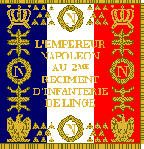
Battle of Beresina, 1812
Poles in bayonet charge, by J.Kossak


"The forced marches of our army often continued till late at night, and in passing the troops we frequently heard Italians, Germans or Frenchmen, singing their national airs to lull their fatigue, or, in this distant and hostile land, to recall a lively remembrance of their absent country." - Albert-Jean-Michel de Rocca
1. Introduction - Foreigners in French Service
2. Tirailleurs du Pô
3. Tirailleurs Corses - "Les Cousins de l'Empereur"
4. Swiss Regiments
5. Polish 'Vistula Legion'
6. Croatian Regiments
7. 'Regiments Etrangers'


Introduction - Foreigners in French Service.
According to Colonel John Elting, the French, being practical people, have always been eager to let any available foreigners assist them in any necessary bleeding and doing for France. The foreigners served for the French kings, for Napoleon and during the 20th Century.
Today the French Foreign Legion is an elite unit. This is a military formation of approximately 8,500 men serving as a branch of the regular Armed Forces of France. It differs from other military units by accepting foreigners from any country in the world into its ranks.
The Ministry of Foreign Affairs was traditionally responsible for the procurement of foreign troops. Most of the foreigners were contingents from allied or vassal states, others were individuas of foreign birth serving in oficially French units. There were also foreign troops recruited for service as part of the French army. In 1803 were formed Bataillon de Tirailleurs du Po (Italians) and so-called Legion du Midi and Legion Hanovrienne (Germans). Groups of volunteers found their way over from Ireland. They formed "Legion Irlandaise" (Irish Legion) and recruited among British prisoners of war. According to magweb.com the Irish Legion, was raised as a light infantry "from the almost endless stream of enthusiastic Irishmen that appeared any time there was an Englishman to be shot." In 1807 were formed Regiment de Westphalie (Germans), Regiment Albanaise (Balkans), Batailllon de Neuchatel and Bataillon de Valaisan (Swiss). There were also four regiments of Swiss infantry, four regiments of Polish 'Vistula Legion' and four regiments of Croats.
Napoleon's foreign troops comprised three categories: (When German, Dutch and Italian territories were annexed the foreigners became very numerous.) (For example the Dutch 'Red Lancers' of the Guard, the Swiss and Croatian regiments, the Polish 'Vistula Legion', Hannoverian Legion, Portuguese Legion, Irish Legion etc. etc.) (For example the Westphalian, Bavarian and Saxon troops participating in 1812 in Napoleon's invasion of Russia. They formed separate corps, or the Polish 8th Corps at the Battle of Leipzig.)
List of French light regiments formed of foreigners:
French line regiments formed of foreigners:
The foreigners also served in Napoleon's Imperial Guard. The Dutch formed 3e Regiment de Grenadiers-à-Pied de la Garde and 2e Regiment de Chevau-Legers-Lanciers de la Garde ("Red Lancers"). The Italians formed Velites of Turin and Velites of Florence. The Poles formed the 1er Regiment de Chevau-Legers-Lanciers de la Garde and in 1812 Napoleon attached the entire 'Vistula Legion' to his Guard. The Germans in the Guard in 1813 were represented by the Saxon Grenadier Battalion and the Westphalian Guard Fusilier Battalion. Earlier on the Berg lancers were attached to the Guard.
The numebr of foreigners in major battles was often significant. Below is a comparison list for the Battle of Borodino (1812):
With the exception of desertion of Saxons at Leipzig, followed by the defection of the Bavarians, the foreigners were loyal and fought well. Below is a comparison list showing average officer casualties per battalion suffered at the Battle of Leipzig. The more battalion or regiment was involved in fighting the heavier were their casualties.
|

Links and Sources.
Elting - "Swords Around a Throne"
Fieffe - "Histoire des Troupes Etranger au service de France"
Mageraud - "Armement et Equiement de l'Infanterie Francaise"
Martinien - "Tableaux par Corps et par Batailles des Officiers tues et blesse pendant les guerres de l'Empire 1805-1815"
Susane - "Histoire de l'Infanterie Francaise"
napoleonseries.org and napoleon-series (articles by Tony Broughton).
Napoleon, His Army and Enemies